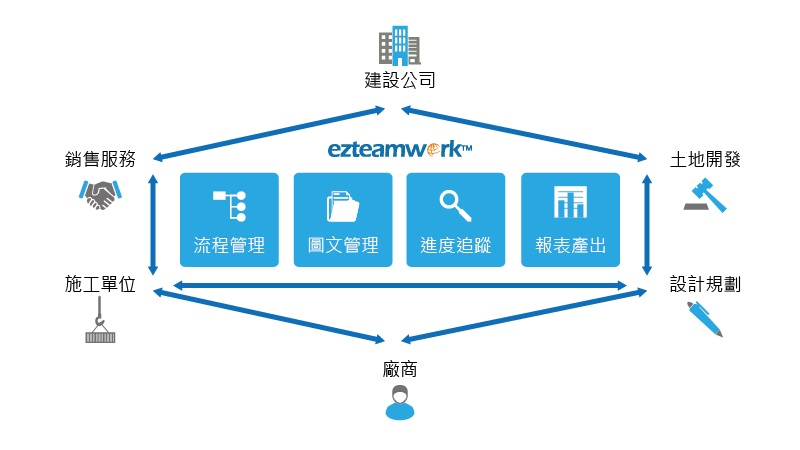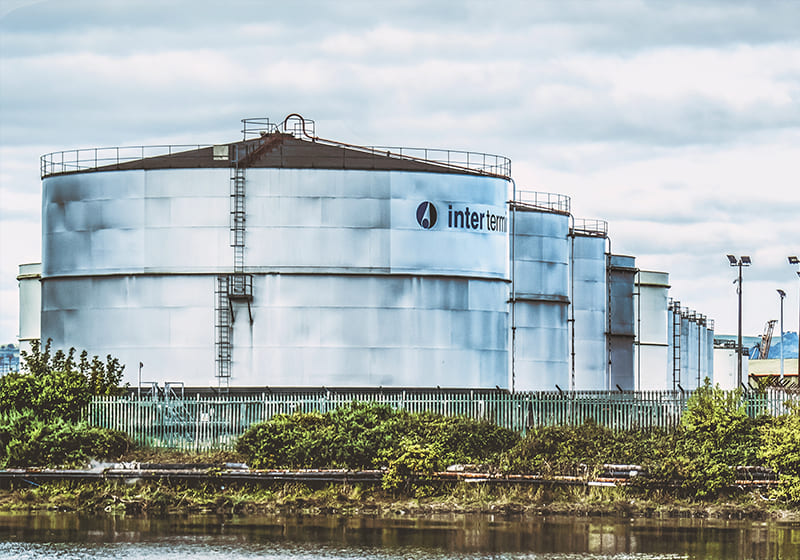Case Study/Project Management
Constructing a construction project management system for the Taichung plant.
Building context/challenges.
1. Control of Engineering Progress and Subcontractors
The four parties involved in engineering project management (owner, design, supervision, construction contractor) all have their own interests to consider. Without a common goal and communication tool, the entire construction project may be difficult to carry out. Typically, construction projects span a long period, and the progress among subcontractors is interrelated. Facing multiple subcontractors and a lack of transparency in project conditions, it becomes difficult to grasp the progress of the schedule, which becomes the biggest problem in management operations.
The case owner manages this construction project through its organizational unit called the "New Construction Department," which is responsible for contract issuance and project management. It is further divided into several groups, including the Management Team, Planning and Progress Team, Engineering Team, and Health, Safety, and Environment Team. Here is a brief overview of the division of labor within this organizational structure:
- Management Team
Supervises and oversees the contracting situation of each subcontractor and the progress status of the construction project. - The Planning and Progress Team
The Planning and Progress Team is responsible for planning the breakdown of the entire project into subcontracting packages, detailing each task, and integrating the progress of each subcontractor. They compile these updates and report them regularly to the Management Team. - Construction Team
The Construction Team conducts reviews, assessments, and reports on the progress of ongoing executions, providing a monthly settlement report. They are also responsible for reviewing construction documents and managing document versions and drawings. - The Safety and Environmental Team.
The Safety and Environmental Team is responsible for managing safety and environmental protection measures for the project. In the event of any incidents, they are required to document the details and report on the follow-up actions taken.
Although there is such detailed division of labor, managing the project status through various audits and statistical reports is quite time-consuming and labor-intensive. In this case, there are nearly 70 subcontractors, and the progress of these subcontracted works is interconnected. If the progress of one subcontractor is delayed, it may lead to significant delays or errors in subsequent project areas or the entire project.
2. Cash Flow Management
Each winning contractor must first submit a construction plan, including the planned project schedule and billing plan, which is then reviewed by the owner to plan the monthly budget. During execution, the project coordinator from the planning progress team estimates and adjusts the cost items and amounts based on the project progress each month and submits them to the finance department. When contractors submit their billing based on actual progress, the construction progress and checkpoint achievements are reviewed by the engineering team for verification. Subsequently, a recheck is conducted by the management team before the finance department proceeds with the fund disbursement process.
While the intricate division of labor seems flawless in theory, in practice, the lack of transparency and real-time updates in the aforementioned progress hinders the planning progress team's ability to accurately forecast cash expenditures. Additionally, discrepancies arise when contractors submit their billing based on estimated progress, which may not align with the actual progress timeline. Moreover, individual schedule revisions for each subcontractor are not easily reflected in the overall progress or the timing of cash requirements. Given the substantial budget of this project, such discrepancies in information and timing may impact the company's financial needs, financial scheduling, and flexibility in response.
3. Graphics and Text Management and Experience Retention
4. Quality Management
Solutions
1. Linking and integrating the progress control of each subcontracting project with the overall construction project.
Originally, the owner would require each subcontractor to submit regular progress reports for their respective projects, and then manually calculate and compile the overall progress to create a comprehensive progress report. This process heavily relied on the reports provided by subcontractors, resulting in significant time spent by the consolidation team on data processing. From data collection to data processing, there was a time gap.
Through the system operation, each subcontract project is treated as a sub-project (or "subcontract project"), with each subcontractor reporting their individual progress to the system. The system then consolidates and calculates the data behind the scenes and integrates it back into the overall construction project. In this mechanism, the progress of each subcontract project is directly and immediately reflected in the overall project. Any changes in engineering or scheduling will also be immediately reflected in the subcontractor's progress report and the overall progress report. With the tight integration provided by the system, there is no information time gap. Additionally, the planning progress team members can save time on consolidating data and focus more on managing the subcontract interface.
2. Linking progress to payments allows for real-time monitoring of monthly cash requirements.
During the execution of the project, if cash outflows consistently exceed inflows, working capital can become tied up in the project. Even if the company has sufficient financial resources to cope, it still loses out on interest and other opportunity costs. If the financial situation is not robust enough, it may lead to operational difficulties.
The original operational model involved subcontractors submitting relevant documentation for verification, which was then reviewed layer by layer by the engineering team, management team, and finance team according to their respective permissions. However, this approach only focused on reviewing the quality, quantity, and reasonableness of the progress that had already occurred, providing limited assistance in cash flow management.
After the system implementation, the operational process is divided into two parts: actual invoicing and forecasted cash outflows. During actual valuation and invoicing, the system automatically checks the total estimated and actual invoiced amounts for each subcontract project to ensure that the cumulative invoiced amount for the period does not exceed the contract amount after any subcontract adjustments. If there is an error, the system automatically sends notifications to the relevant personnel in accounting and the subcontractor. When adjusting the project schedule and progress, the expected invoicing schedule and amounts are also automatically adjusted to forecast future cash outflows.
The system also automatically generates cash flow charts, which clearly indicate whether the cumulative cash outflows for this construction project exceed the originally planned cash inflows, or when they might surpass the original plan. This allows for early planning and response to any potential discrepancies, significantly strengthening cash flow management.
3. Automatic numbering of drawing versions and automatic generation of a Drawing List.
Whether it's the initial design drawings, the contracts and specifications documents during procurement and bidding, or the construction drawings and technical documents after contracting, the entire construction process generates a large amount of data and documents. With traditional management methods, it becomes impossible to cope with the vast demands of document and graphic management.
Firstly, improve the practice of using folders for file classification management. Since the production of documents and drawings is closely related to each task, when planning project work, define what kind of documents will be generated at each stage. Therefore, document access becomes quite intuitive. As long as you find the corresponding stage and task, you can find the document without having to search through layers of folders.
Secondly, by uploading or updating documents through the system, version management is automatically performed. When a user wants to download a document, the system automatically checks permissions and provides the latest version, while also recording download history. This significantly reduces the occurrence of accessing incorrect versions and allows tracking of whether the generated documents have been accessed and used by relevant personnel. Since the system automatically records the revision history of each document, it can automatically create lists of all documents categorized by type and display the time of each version, thus generating a Drawing List.
In addition, the system also provides a paperless review mechanism, allowing authorized personnel to conduct online reviews. Through this digitalized process, operational efficiency in document management is enhanced, paper costs are reduced, and the time spent searching for documents is shortened.
4. Automation of Issue Management and Tracking
All recorded issues and deficiencies are logged in the system, with set deadlines for resolution. The system automatically generates issue tracking reports to assist project managers in monitoring the latest status of each issue. When the deadline approaches, reminder emails are sent to ensure timely resolution of the matter.
Benefits of implementation.
Taiwan Fertilizer Co., Ltd. was founded on May 1, 1946. During the state-owned period, it fully cooperated with government policies to produce and supply fertilizers needed for domestic agricultural development, making it the largest modern fertilizer production enterprise in Taiwan. On September 1, 1999, it completed its public offering and successfully transformed into a privately-owned company listed on the stock market. Taiwan Fertilizer's main business operations focus on fertilizer production. In response to social development and urban renewal needs, Taiwan Fertilizer consolidated the fertilizer and chemical production of other old plants in Taichung to establish the Taichung Plant. Officially inaugurated in July 2013, the plant is located adjacent to the expansive Taichung Port West Pier, covering an area of approximately 30 hectares. It features two deep-water piers capable of unloading both liquid and solid raw materials, with the primary focus on chemical products (nitric acid, sulfuric acid, sulfonic acid, etc.), fertilizer products, and procurement and storage business.
Industry category.
Chemical manufacturing industry
Solutions
Engineering & Construction
Related cases
BAOPU DEVELOPMENT
Improving efficiency by monitoring task assignment progress.
Jiuh Horng co., ltd .
Integrating progress tracking with drawing revision control.
TING TAI CONSTRUCTION CO., LTD.
Constructing a construction project management platform.
TAIWAN FERTILIZER CO.,LTD.
Constructing a factory building construction management system.





